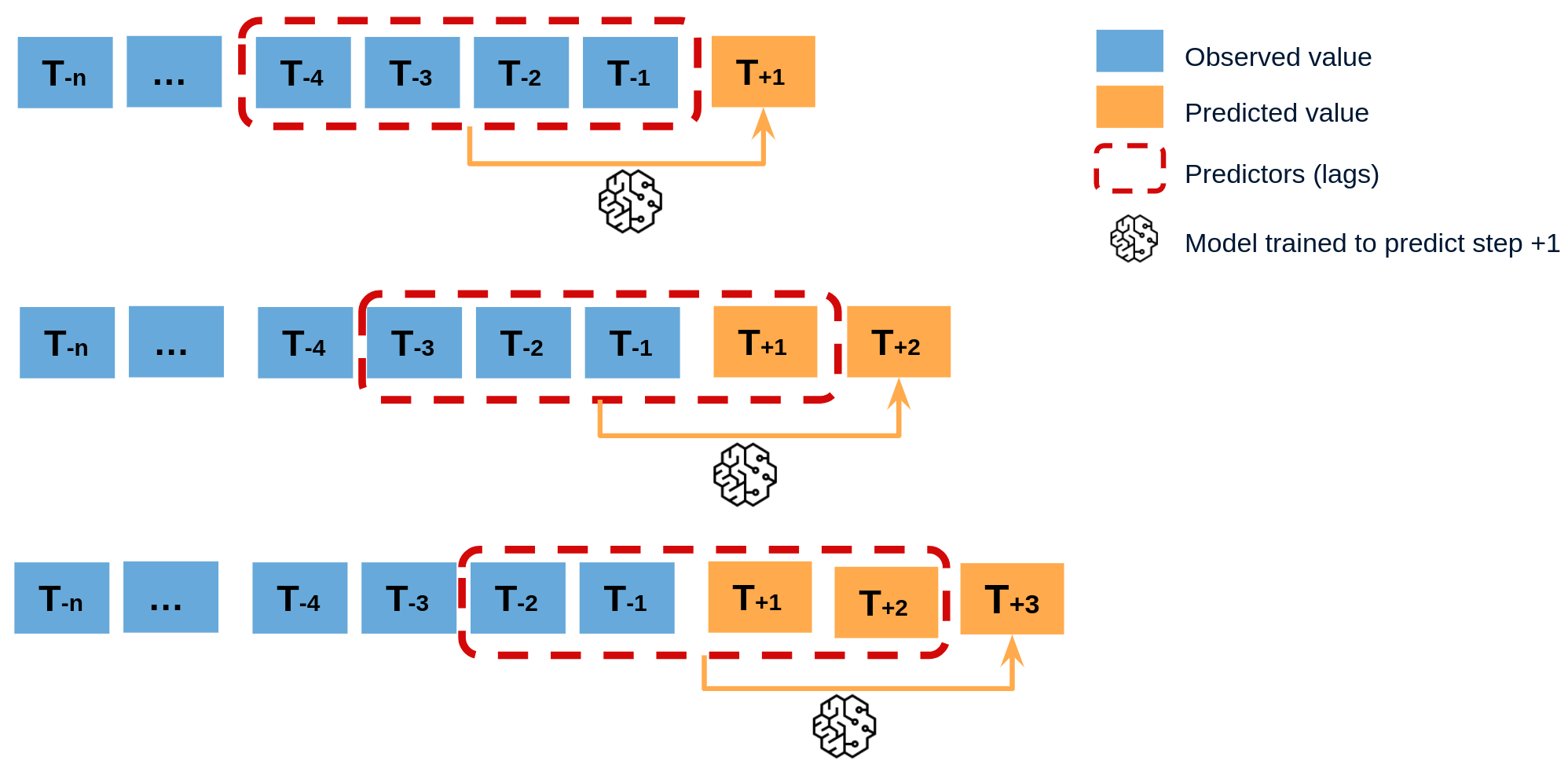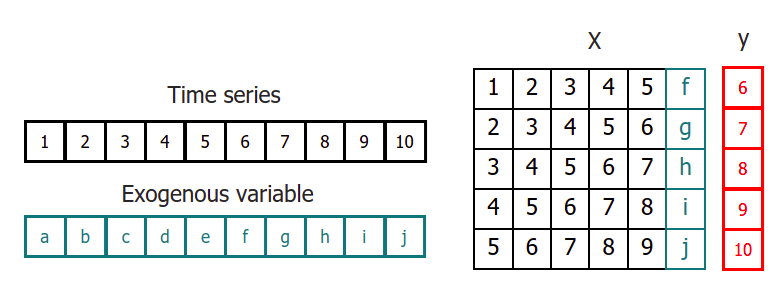Recursive multi-step forecasting¶
Recursive multi-step forecasting involves using the predicted values from previous time steps as input to forecast the values for the subsequent time steps. The model initially predicts one time step ahead and then uses that forecast as an input for the next time step, continuing this recursive process until the desired forecast horizon is reached.
To clarify, since the value of $t_{n-1}$ is required to predict $t_{n}$, and $t_{n-1}$ is unknown, a recursive process is applied in which, each new prediction is based on the previous one.

Diagram of recursive multi-step forecasting

Recursive forecasting
When using machine learning models for recursive multi-step forecasting, one of the major challenges is transforming the time series data into a matrix format that relates each value of the series to the preceding time window (lags). This process can be complex and time-consuming, requiring careful feature engineering to ensure the model can accurately capture the underlying patterns in the data.

Time series transformation including an exogenous variable
By using the classes ForecasterRecursive, it is possible to build machine learning models for recursive multi-step forecasting with ease. These classes can automatically transform the time series data into a matrix format suitable for input to a machine learning algorithm, and provide a range of options for tuning the model parameters to achieve the best possible performance.
Libraries and data¶
# Libraries
# ==============================================================================
import pandas as pd
import matplotlib.pyplot as plt
from lightgbm import LGBMRegressor
from sklearn.metrics import mean_squared_error
from skforecast.datasets import fetch_dataset
from skforecast.preprocessing import RollingFeatures
from skforecast.recursive import ForecasterRecursive
# Download data
# ==============================================================================
data = fetch_dataset(
name="h2o", raw=True, kwargs_read_csv={"names": ["y", "datetime"], "header": 0}
)
# Data preprocessing
# ==============================================================================
data['datetime'] = pd.to_datetime(data['datetime'], format='%Y-%m-%d')
data = data.set_index('datetime')
data = data.asfreq('MS')
data = data['y']
data = data.sort_index()
# Split train-test
# ==============================================================================
steps = 36
data_train = data[:-steps]
data_test = data[-steps:]
# Plot
# ==============================================================================
fig, ax = plt.subplots(figsize=(6, 3))
data_train.plot(ax=ax, label='train')
data_test.plot(ax=ax, label='test')
ax.legend();
h2o --- Monthly expenditure ($AUD) on corticosteroid drugs that the Australian health system had between 1991 and 2008. Hyndman R (2023). fpp3: Data for Forecasting: Principles and Practice(3rd Edition). http://pkg.robjhyndman.com/fpp3package/,https://github.com/robjhyndman /fpp3package, http://OTexts.com/fpp3. Shape of the dataset: (204, 2)
Create and train forecaster¶
# Create and fit forecaster
# ==============================================================================
forecaster = ForecasterRecursive(
regressor = LGBMRegressor(random_state=123, verbose=-1),
lags = 15,
window_features = RollingFeatures(stats=['mean'], window_sizes=10)
)
forecaster.fit(y=data_train)
forecaster
ForecasterRecursive
General Information
- Regressor: LGBMRegressor
- Lags: [ 1 2 3 4 5 6 7 8 9 10 11 12 13 14 15]
- Window features: ['roll_mean_10']
- Window size: 15
- Exogenous included: False
- Weight function included: False
- Differentiation order: None
- Creation date: 2024-11-08 16:33:48
- Last fit date: 2024-11-08 16:33:48
- Skforecast version: 0.14.0
- Python version: 3.11.10
- Forecaster id: None
Exogenous Variables
-
None
Data Transformations
- Transformer for y: None
- Transformer for exog: None
Training Information
- Training range: [Timestamp('1991-07-01 00:00:00'), Timestamp('2005-06-01 00:00:00')]
- Training index type: DatetimeIndex
- Training index frequency: MS
Regressor Parameters
-
{'boosting_type': 'gbdt', 'class_weight': None, 'colsample_bytree': 1.0, 'importance_type': 'split', 'learning_rate': 0.1, 'max_depth': -1, 'min_child_samples': 20, 'min_child_weight': 0.001, 'min_split_gain': 0.0, 'n_estimators': 100, 'n_jobs': None, 'num_leaves': 31, 'objective': None, 'random_state': 123, 'reg_alpha': 0.0, 'reg_lambda': 0.0, 'subsample': 1.0, 'subsample_for_bin': 200000, 'subsample_freq': 0, 'verbose': -1}
Fit Kwargs
-
{}
Prediction¶
# Predict
# ==============================================================================
predictions = forecaster.predict(steps=36)
predictions.head(3)
2005-07-01 1.026507 2005-08-01 1.042429 2005-09-01 1.116730 Freq: MS, Name: pred, dtype: float64
# Plot predictions
# ==============================================================================
fig, ax = plt.subplots(figsize=(6, 3))
data_train.plot(ax=ax, label='train')
data_test.plot(ax=ax, label='test')
predictions.plot(ax=ax, label='predictions')
ax.legend();
# Prediction error
# ==============================================================================
error_mse = mean_squared_error(
y_true = data_test,
y_pred = predictions
)
print(f"Test error (mse): {error_mse}")
Test error (mse): 0.006632513357651682
Prediction intervals¶
A prediction interval defines the interval within which the true value of y is expected to be found with a given probability. For example, the prediction interval (1, 99) can be expected to contain the true prediction value with 98% probability.
By default, every forecaster can estimate prediction intervals using the method predict_interval. For a detailed explanation of the different prediction intervals available in skforecast visit Probabilistic forecasting.
# Predict intervals
# ==============================================================================
predictions = forecaster.predict_interval(steps=36, interval=[5, 95], n_boot=100)
predictions.head(3)
| pred | lower_bound | upper_bound | |
|---|---|---|---|
| 2005-07-01 | 1.026507 | 0.986691 | 1.063817 |
| 2005-08-01 | 1.042429 | 1.001314 | 1.100771 |
| 2005-09-01 | 1.116730 | 1.079703 | 1.153881 |
# Plot prediction interval
# ==============================================================================
fig, ax = plt.subplots(figsize=(6, 3))
data_test.plot(ax=ax, label="test")
predictions['pred'].plot(ax=ax, label="prediction")
ax.fill_between(
predictions.index,
predictions['lower_bound'],
predictions['upper_bound'],
color = 'blue',
alpha = 0.3,
label = '80% interval'
)
ax.legend(loc="upper left");
Feature importances¶
forecaster.get_feature_importances()
| feature | importance | |
|---|---|---|
| 11 | lag_12 | 88 |
| 10 | lag_11 | 47 |
| 1 | lag_2 | 45 |
| 0 | lag_1 | 35 |
| 12 | lag_13 | 35 |
| 15 | roll_mean_10 | 30 |
| 8 | lag_9 | 29 |
| 6 | lag_7 | 28 |
| 5 | lag_6 | 26 |
| 13 | lag_14 | 24 |
| 2 | lag_3 | 23 |
| 14 | lag_15 | 20 |
| 4 | lag_5 | 19 |
| 9 | lag_10 | 19 |
| 3 | lag_4 | 17 |
| 7 | lag_8 | 15 |
Training and prediction matrices¶
While the primary goal of building forecasting models is to predict future values, it is equally important to evaluate if the model is effectively learning from the training data. Analyzing predictions on the training data or exploring the prediction matrices is crucial for assessing model performance and understanding areas for optimization. This process can help identify issues like overfitting or underfitting, as well as provide deeper insights into the model’s decision-making process. Check the How to Extract Training and Prediction Matrices user guide for more information.
Differentiation¶
Time series differentiation involves computing the differences between consecutive observations in the time series. When it comes to training forecasting models, differentiation offers the advantage of focusing on relative rates of change rather than directly attempting to model the absolute values. Once the predictions have been estimated, this transformation can be easily reversed to restore the values to their original scale.
💡 Tip
To learn more about modeling time series differentiation, visit our example: Modelling time series trend with tree based models.
# Create and fit forecaster
# ==============================================================================
forecaster = ForecasterRecursive(
regressor = LGBMRegressor(random_state=123, verbose=-1),
lags = 15,
differentiation = 1
)
forecaster.fit(y=data_train)
forecaster
ForecasterRecursive
General Information
- Regressor: LGBMRegressor
- Lags: [ 1 2 3 4 5 6 7 8 9 10 11 12 13 14 15]
- Window features: None
- Window size: 16
- Exogenous included: False
- Weight function included: False
- Differentiation order: 1
- Creation date: 2024-11-08 16:33:51
- Last fit date: 2024-11-08 16:33:51
- Skforecast version: 0.14.0
- Python version: 3.11.10
- Forecaster id: None
Exogenous Variables
-
None
Data Transformations
- Transformer for y: None
- Transformer for exog: None
Training Information
- Training range: [Timestamp('1991-07-01 00:00:00'), Timestamp('2005-06-01 00:00:00')]
- Training index type: DatetimeIndex
- Training index frequency: MS
Regressor Parameters
-
{'boosting_type': 'gbdt', 'class_weight': None, 'colsample_bytree': 1.0, 'importance_type': 'split', 'learning_rate': 0.1, 'max_depth': -1, 'min_child_samples': 20, 'min_child_weight': 0.001, 'min_split_gain': 0.0, 'n_estimators': 100, 'n_jobs': None, 'num_leaves': 31, 'objective': None, 'random_state': 123, 'reg_alpha': 0.0, 'reg_lambda': 0.0, 'subsample': 1.0, 'subsample_for_bin': 200000, 'subsample_freq': 0, 'verbose': -1}
Fit Kwargs
-
{}
# Predict
# ==============================================================================
predictions = forecaster.predict(steps=36)
predictions.head(3)
2005-07-01 0.909529 2005-08-01 0.941633 2005-09-01 1.007650 Freq: MS, Name: pred, dtype: float64